Ancient and Classical Advertising
Advertising traces its origins to ancient civilizations. In Egypt, merchants used papyrus to create sales messages and wall posters. In ancient Greece and Rome, lost-and-found notices were common on papyrus, and political campaign displays adorned city walls. Wall or rock paintings for commercial advertising have been found in ancient Arabia and Pompeii. In ancient China, oral advertising was prevalent, with bamboo flutes played to sell confectionery, as recorded in the Classic of Poetry (11th to 7th centuries BCE). A copper printing plate from the Song dynasty (960–1279 CE) was used to print posters featuring a rabbit logo and promotional text, considered one of the earliest identified printed advertising mediums. Advertising
Medieval to Early Modern Period
The invention of the printing press by Johannes Gutenberg in the 15th century revolutionized advertising. The mass production of printed materials allowed for the widespread distribution of handbills, posters, and trade cards. In the 17th century, newspapers began to feature advertisements, primarily promoting books and medicines. By the 18th century, advertisements had become a regular feature in newspapers, with content expanding to include a variety of goods and services. History of Advertising
19th Century: Industrial Revolution and Advertising Agencies
The Industrial Revolution led to mass production and urbanization, increasing the need for effective advertising to reach larger audiences. This period saw the rise of advertising agencies. In 1841, Volney B. Palmer established the first advertising agency in Philadelphia, offering services such as media buying and copywriting. History of Advertising
20th Century: The Golden Age and Technological Advancements
The early 20th century marked the emergence of mass marketing strategies. Advertisers began to harness human instincts, appealing to emotions and desires to influence consumer behavior. Edward Bernays, a pioneer in public relations, emphasized the importance of targeting unconscious desires in advertising campaigns. Advertising
The 1950s and 1960s are often referred to as the "Golden Age of Advertising." This era saw the rise of television as a dominant advertising medium, allowing for the combination of visual and auditory elements to create compelling narratives. Iconic campaigns, such as Volkswagen's "Think Small" and Coca-Cola's "Hilltop," exemplified the creative potential of television advertising. Advertising History
Late 20th to 21st Century: Digital Revolution
The advent of the internet in the late 20th century transformed advertising. Digital platforms enabled targeted advertising, with data analytics allowing for personalized marketing strategies. The rise of social media platforms in the 2000s further revolutionized the industry, providing new avenues for engagement and interaction between brands and consumers. Advertising History
Impact of Advertising
Advertising has a profound impact on consumer behavior, shaping purchasing decisions and brand perceptions. It plays a crucial role in economic growth by stimulating demand and fostering competition. Additionally, advertising influences cultural trends and societal norms, reflecting and shaping values and lifestyles. Advertising
Types of Advertising
Advertising manifests in various forms, including:
- –Print Advertising: Newspapers, magazines, brochures, and flyers.
- –Broadcast Advertising: Radio and television commercials.
- –Outdoor Advertising: Billboards, posters, and transit ads.
- –Digital Advertising: Online banners, social media ads, and email marketing.
- –Product Placement: Integrating products into movies, TV shows, or other media.
Each type leverages different channels and techniques to reach target audiences effectively. Advertising
Advertising Theories
Several models attempt to explain how advertising influences consumers. The hierarchy-of-effects model outlines steps a consumer takes from awareness to purchase. Means-end theory suggests that advertisements should link product attributes to personal values, creating a meaningful connection with the consumer. Advertising
Regulation and Ethics
Advertising is subject to regulations to prevent misleading claims and protect consumers. Ethical considerations include avoiding false advertising, respecting privacy, and promoting socially responsible messages. Regulatory bodies, such as the Federal Trade Commission (FTC) in the United States, oversee advertising practices to ensure compliance with laws and standards. Advertising
Future Trends
The future of advertising is likely to be shaped by advancements in technology, including artificial intelligence and machine learning, enabling more personalized and interactive experiences. The increasing importance of data privacy and consumer trust will also influence advertising strategies, with a focus on transparency and ethical practices. Advertising
